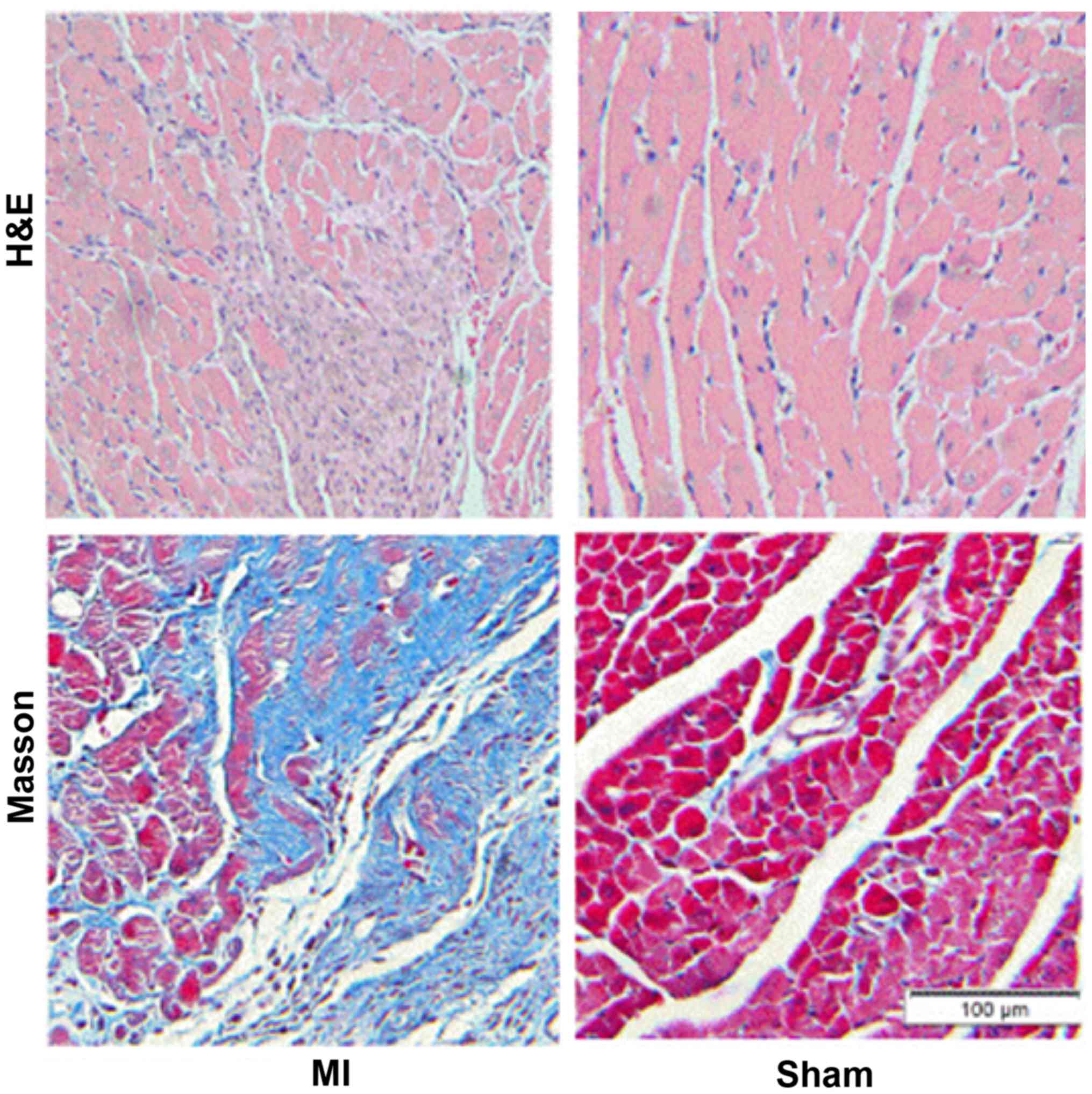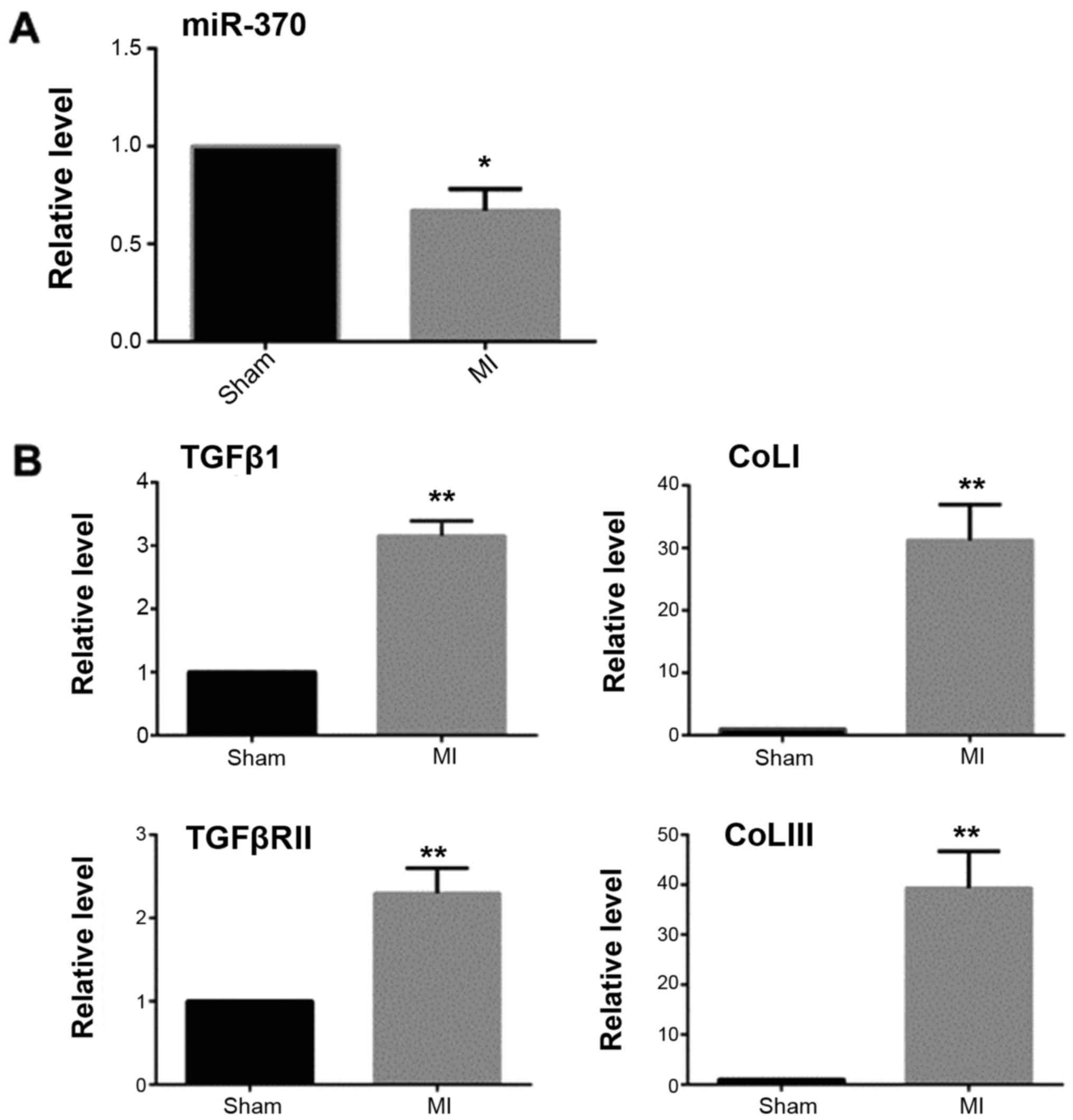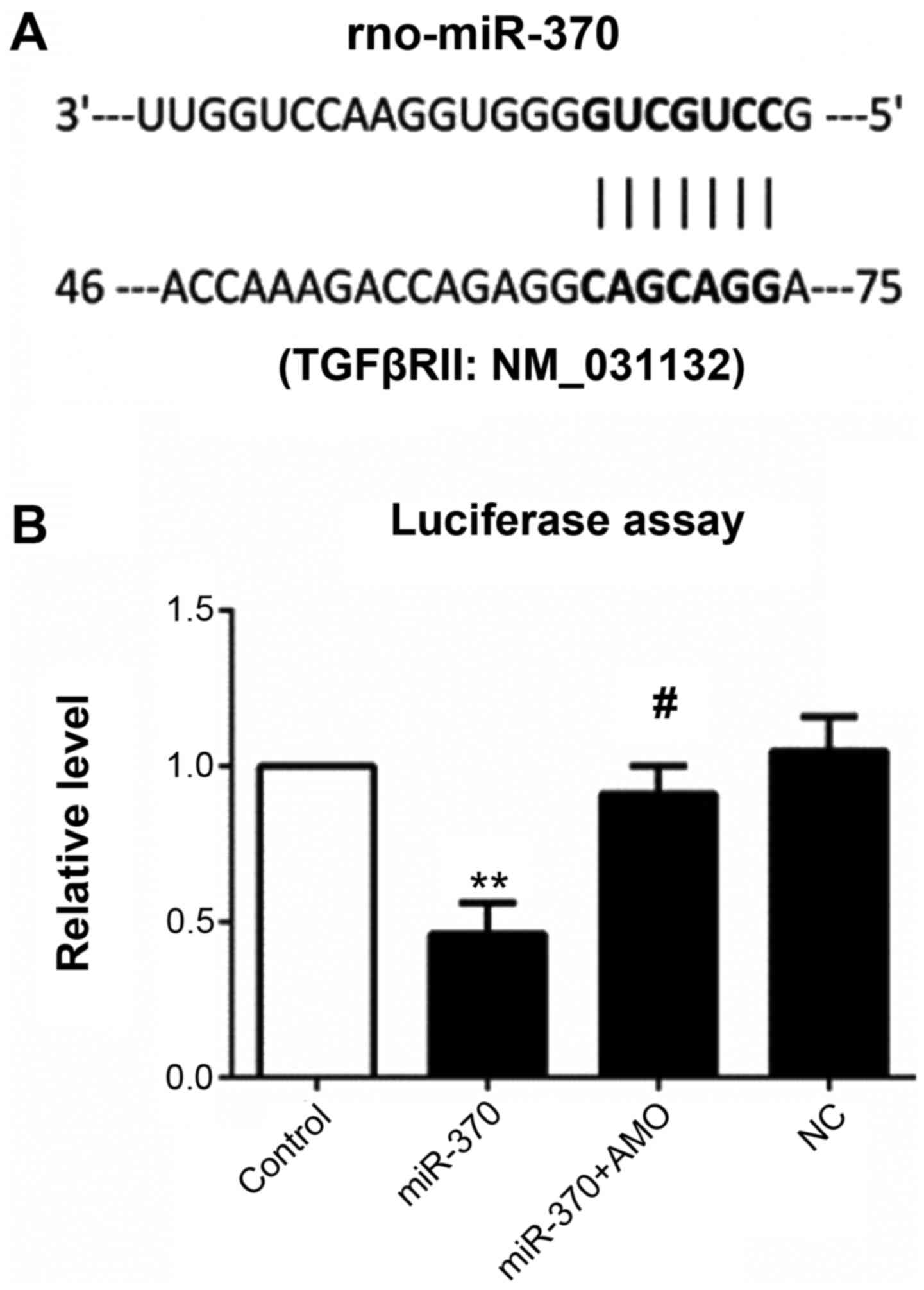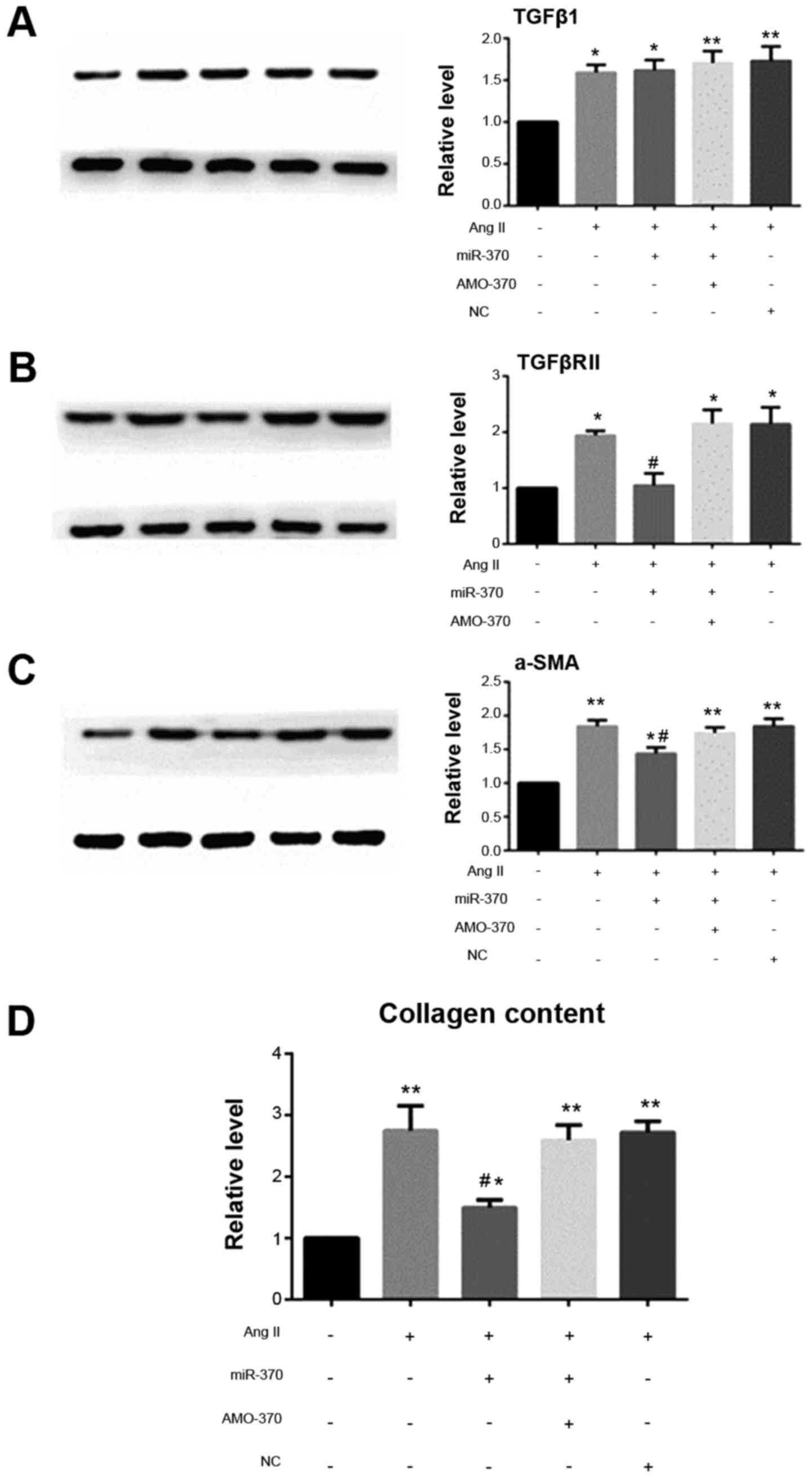The role of miR‑370 in fibrosis after myocardial infarction
- Authors:
- Published online on: March 27, 2017 https://doi.org/10.3892/mmr.2017.6397
- Pages: 3041-3047
-
Copyright: © Yuan et al. This is an open access article distributed under the terms of Creative Commons Attribution License.
Abstract
Introduction
Cardiovascular disease induces the highest incidence, morbidity and mortality worldwide (1). The resulting cardiac remodeling is associated with the underlying pathological changes in most heart diseases (myocardial infarction, heart failure and atrial fibrillation), and myocardial fibrosis is the most important pathological feature of cardiac tissue remodeling (2). Cardiac fibroblasts (CFbs) account for 2/3 of heart cells, which plays an important role in the homeostasis of the cardiac extracellular matrix metabolism and remodeling of cardiac tissue (3). Studies on the biological activity of CFbs (proliferation, differentiation and migration) may provide the basis for exploring the mechanism of cardiac remodeling and developing new therapeutic strategies.
It has been widely confirmed that the transforming growth factor-β1 (TGFβ1) signal transduction pathway plays an important role in the process of cardiac fibrosis (3). TGFβ1 acts on downstream transcription factors and then regulates the expression of target genes and proteins through the binding on their receptors namely TGFβ receptor one and two (TGFβRI/TGFβRII) (4). It can promote the transformation of CFbs into its active myofibroblasts form, which enhances the migration, proliferation and collagen synthesis, and thus, leads to fibrosis (5).
However, microRNAs (miRNAs), a kind of small RNA of 18–24 bp length, can inhibit such a process. Indeed, mature miRNAs combine with 3′ untranslated regions (3′-UTR) of the gene and inhibit the target gene transcription and/or degrade the target gene mRNAs, which affects the expression of the target proteins (6). Accordingly, an increasing number of studies have indicated that miRNAs play an important role in many kinds of heart diseases (7).
The present study mainly focused on the role of miR-370 in the myocardial remodeling after myocardial infarction
Materials and methods
Rat myocardial infarction models
Experiments were in compliance with the council of China on Animal Care and were approved by the Animal Ethics Committee of the Medical College of He Xi University. Sprague-Dawley (SD) male rats (180–250 g) were randomly divided into two groups including, the myocardial infarction group (n=3) and sham operation group (n=3). Rats were anesthetized with pentobarbital sodium (0.1%) and were assisted breathing with small animal ventilator. Their electrocardiograms were recorded with II leads and the third, fourth rib gap was open to expose the left atrial appendage. Anterior descending artery was ligated with 7–0 ligation line 2 mm at the lower edge of the right in the left atrial appendage. Two weeks later, rats were anesthetized, and the heart was quickly removed. After the residual blood was washed with normal saline, the samples were stored at −80°C.
Hematoxylin and eosin (H&E) and Masson staining
Rats of both groups were anesthetized, and their heart was taken out. Saline was used to wash residual blood. Following 24 h of fixation with 4% poly-formaldehyde, tissues were embedded with paraffin, sliced and stained using H&E and Masson procedures.
Cell culture and treatment
The epicardium of heart of SD neonatal rats (1–3 days) was tore with pincett. The residual blood was washed with 1X PBS. The sample was cut with a pair of scissors (about 1 mm3), and double enzymes were added (0.25% pancreatin + 0.1% collagenase B) to digest at 37°C using shock for a total of 10 times, initially for 10 min, and then 6 min each time. The supernatant of each collection was terminated digestion with DMEM culture medium (Gibco; Thermo Fisher Scientific, Inc., Waltham, MA, USA) containing 10% fetal bovine serum (FBS, Gibco). After centrifugation of cell suspension at 800 × g for 10 min, the cells were cultured in 50 ml culture flask after resuspension with 10% FBS, and then stored at 37°C in a 5% CO2 incubator. CFb was obtained after differential for 75 min and discarding the supernatant. Cells were cultured with 10% FBS DMEM and 5% CO2 at 37°C. Cell passage occurred in 1–2 days, and cells between passages 2–3 were used for experiments. Serum-free DMEM was used to starve cells for 24 h.
Cell transfection
After washing with serum-free DMEM, the cells were cultured with 2 ml serum-free DMEM for 4–6 h (6-well plate). miR-370 mimics (5′-CAGGUCACGUCUCUGCAGUUACAC-3′), miR-370 antisense inhibitor (5′-GTCCAGTGCAGAGACGTCAATGTG-3′), NC (5′-CACAUUGTGCUCUCUGCACUGCTC-3′) (Guangzhou RioBio Co., Ltd., Guangzhou, China) and transfection reagent lipofectmine®2000 (Invitrogen Life Technologies, Carlsbad, CA, USA) and 500 µl Opti-MEM (Gibco) were mixed, with a standing time of 5 min. Two kinds of mixture mixed and stood for 20 min, and then transfected cells. 6 h later, culture medium was replaced and corresponding stimulation was added.
Measurement of collagen protein
After treatment with the Sircol collagen assay kit (Biocolor), cell samples were stored at 4°C for 24 h. After centrifugation, 100 µl supernatant was added with 1 ml Sircol dye, mixing, 4°C, 30 min. After centrifugation, the supernatant was removed and 700 µl Sircol alkali reaction fluid was resuspended. Data were obtained using a spectrophotometer (540 nm; Hitachi, Tokyo, Japan).
Real-time fluorescence quantitative polymerase chain reaction (qRT-PCR)
Total RNA in cardiac tissue and CFbs was extracted with TRIzol (Invitrogen Life Technologies). Levels of GAPDH, ColIa1, ColIIIa1, TGFβ1, TGFβRII and miR-370 were detected with qRT-PCR and SYBR-Green (Takara Bio, Dalian, China) (Table I).
Western blotting
Total protein in cardiac tissue and CFbs was extracted with protein lysis buffer (Beyotime Biotech, Jiangsu, China). Proteins were isolated using 60 µg protein system and 10% SDS polyacrylamide gel, and transferred to the polyvinylidene fluoride membrane. After three hours of blocking with 5% skim milk, TGFβ1, TGFβRII, a-SMA (a-smooth muscle actin, Gene Tex) and internal reference APDH (Anti Gene) primary antibody diluent was used to seal the membrane for 16 h. 1X TBST washing membrane for 15 min each time for a total of three times. The secondary antibody (Anti Gene) dilution was incubated for 2 h and then membranes were washed in 1X TBST for 15 min each time for a total of three times. Thereafter, ECL (Thermo Fisher Scientific, Waltham, MA, USA) luminescence was applied. The Bio-Rad Biology system was used to capture images and the results were analyzed.
Target gene prediction of miRNA
We used two databases, TargetScan6.2 (http://www.targetscan.org/index.html) and PicTar (http://pictar.mdc-berlin.de), to predict the combination of miR-370 and TGFβII mRNA.
Dual luciferase reporter gene assay
3′-UTR in TGFβRII was sub-cloned based on PCR, and the miRNA binding site in reporter gene vector was constructed. The construct was inserted into multiple cloning sites. After miRNA reporter vector (Ambion Life Technologies, Carlsbad, CA, USA) expressed by pMIR-REPORT™ luciferase (HindIII and SpeI sites) in the serum-free medium for 24 h, human embryonic kidney cell (HEK-293) (1≤105/well) 1ug PGL3 target DNA (firefly luciferase vector) and 0.1 µg pRL-TK (Ranilla luciferase vector driven by TK) were transfected using liposome (Lipofectamine® 2000, Invitrogen Life Technologies). Forty-eight hours after transfection of dual luciferase, double luciferase activity was detected, strictly according to the method provided by Promega (8).
Statistical analysis
Statistical analysis was performed using SPSS 13.0 (SPSS, Inc., Chicago, IL, USA) and GraphPad Prism (version 6.0; GraphPad Software, Inc, La Jolla, CA, USA). All data were expressed as mean ± standard error. Analysis of variance and Dunnett's test were conducted in comparisons among multiple groups. P<0.05 was considered to indicate a statistically significant difference.
Results
miR-370 expression decreases after myocardial infarction, whereas the expression of TGFβ1 and TGFβRII increases
MASSON staining and qRT-PCR results showed that 2 weeks after myocardial infarction, the collagen deposition in the infarct border area was significantly increased in the myocardial infarction group when compared with the sham operation group (Fig. 1). The expression of TGFβ1 and TGFβRII was significantly increased and miR-370 expression decreased in the border area of the heart infarction. Western blotting results showed that the expression of α-SMA was also significantly increased in the border area, which suggested that CFbs in the infarct border area partially differentiated into myofibroblasts (Figs. 2 and 3).
AngII promotes the differentiation of CFbs and collagen secretion and inhibits the expression of miR-370
When SD rat CFbs were passaged for the third generation and cells were fused to 85%, the cells were synchronized with serum-free DMEM for 24 h and stimulated with AngII for 24 h, and then the indicators were detected. It showed that TGFβ1, and TGFβRII mRNA and protein levels were increased in fibroblasts under the induction of AngII. The increase of α-SMA promoted the transformation of fibroblasts into myofibroblasts and increased the expression of collagen. The results also showed that AngII significantly inhibited the expression of CFb miR-370, which indicated that the decrease of miR-370 may be related to the increase of TGFβRII.
miR-370 inhibits TGFBRII expression and inhibits myocardial fibrosis induced by AngII
Dual luciferase reporter gene assay showed that luciferase activity was significantly decreased in the plasmid group co-transfected with miR-370 mimics and contained the 3′UTR gene sequence of TGFβRII when compared with the control group. miR-370 mimics and inhibitor co-transfection significantly inhibited decreased luciferase activity induced by miR-370 mimics, while there were no effects in the NC transfection group (Fig. 4).
qRT-PCR results showed that the levels of TGFβRII, ColI1a and ColIII1a mRNAs in the miR-370 mimics + AngII group were significantly decreased compared with the AngII group. There were no significant differences in the levels of the above indexes in the miR-370 inhibitor + AngII, NC + AngII and AngII groups. Level of TGFβ1 mRNA did not differ in the above four groups. Western blot analysis revealed that, compared with the other three groups, TGFβRII and α-SMA protein levels and collagen secretion decreased in the miR-370 mimics + AngII group, however, miR-370 mimics did not inhibit the increase in TGFβ1 induced by AngII (Figs. 5 and 6).
Discussion
The present study showed that the expression of miR-370 in the myocardium was decreased after myocardial infarction. It can inhibit the myocardial remodeling induced by AngII after myocardial infarction. The underlying mechanism is that miR-370 reduces the expression of TGFβRII, inhibits the TGFβ1-SMAD signal transduction pathway so as to exert the effects of inhibiting myocardial fibrosis.
It has been confirmed that the expression of miR-370 in peripheral blood leukocytes was higher in patients with acute coronary syndrome than that in normal patients (9). But the expression of miR-370 in the myocardium after myocardial infarction and the corresponding mechanisms have not been studied. The present study showed that in myocardial remodeling, the expression of miR-370 in the infarct border area was decreased after myocardial infarction. Fibroblasts differentiated into myofibroblasts and collagen secretion was increased. AngII promoted the expression of TGFβ1 and TGFβRII in CFbs and inhibited the expression of miR-370 at the same time. miR-370 can be combined with the 3-UTR in TGFβRII mRNA and inhibit the expression of TGFβRII, which result in the inhibition of the biological effects of AngII on CFbs, including differentiation of CFbs and the increase of collagen expression. However, miR-370 did not block the increase in TGFβ1 induced by AngII. The results suggested that the biological effects of miR-370 on AngII may be mediated by inhibiting TGFβRII expression and blocking downstream signal transduction pathways, but not inhibiting the generation of TGFβ1.
Myocardial remodeling in myocardial infarction is divided into two stages. The first stage is the physiological repair after infarction, which belongs to the protective repair. The second stage is the pathological remodeling caused by the continuous accumulation of extracellular matrix (9). In pathological remodeling after myocardial infarction, CFbs transform into α-SMA positive myofibroblasts under the continuous action of multiple biological effector molecules, such as AngII, TNF-α and TGF-β. The ability of myofibroblasts to migrate, proliferate and secrete collagen is obviously stronger. Hence, the transformation into myofibroblasts is the key link of pathological remodeling after infarction (10).
TGFβ1-SMAD signal transduction pathway plays an important role in the process of cardiac remodeling. Previous studies have indicated that many induced fibrosis factors, such as AngII and ET1, take effect by promoting the expression of TGFβ1 (11). Indeed, TGFβ1 is the key factor of fibrogenic effects. TGFβ1 has an effect on TGFβ receptor complex on the cell surface and leads to the phosphorylation of downstream transcription factor SMAD2/3, which is further combined with SMAD4 to form the complex. The complex enters into the cell and combines with cellular DNA, or it can form a special transcription factor to regulate the target genes and target proteins (4). Previous findings have shown that nicotine can lead to atrial fibrosis in dogs by increasing the expression of TGFβRII receptor in the atrial fibroblasts, enhancing the downstream signal transduction and increasing the expression of collagen (12).
An increasing number of microRNAs including Let-7, mir-133 and −30c have been shown to exert an inhibitory effect on organ fibrosis by blocking the TGFβ1-TGFβRI/TGFβRII-SMAD signal transduction pathway (13,14). Of these, Let-7 has been shown to inhibit the expression of TGFβRI and thus, play a protective role in renal fibrosis (15). miR-24 was demonstrated to exert anti-fibrotic effects by inhibiting the expression of TGFβ1 in CFbs (15). miR-21, a small RNA that has been widely confirmed to have fibrogenic effects, has also been shown that it leads to fibrosis by inhibiting the expression of TGFβRIII, seen that TGFβRIII can inhibit TGFβRI/II, thereby promoting TGFβRI/II-induced downstream signal transduction (16,17). A recent study has showed that nicotine in tobacco reduced mir-590 in dog atrial fibroblasts, increased the expression of TGFβRII and then enhanced the secretion of collagen and proliferation (12). This suggests that it is feasible to affect the expression of TGFβR and to inhibit myocardial fibrosis through the intervention of miRNAs levels.
In total, our results suggest that miR-370 exerts anti-fibrotic effects by decreasing the expression level of TGFβRII and inhibiting TGFβ1-TGFβRI/II-SMAD signal transduction pathway. However, a large number of studies are needed to validate the specific mechanisms of miRNAs in myocardial remodeling after myocardial infarction and the application of miRNAs in the treatment of cardiovascular diseases.
References
|
Poole-Wilson P: The prevention of cardiovascular disease worldwide: Whose task and WHO's task? Clin Med (Lond). 5:379–384. 2005. View Article : Google Scholar : PubMed/NCBI | |
|
Porter KE and Turner NA: Cardiac fibroblasts: At the heart of myocardial remodeling. Pharmacol Ther. 123:255–278. 2009. View Article : Google Scholar : PubMed/NCBI | |
|
Shinde AV and Frangogiannis NG: Fibroblasts in myocardial infarction: A role in inflammation and repair. J Mol Cell Cardiol. 70:74–82. 2013. View Article : Google Scholar : PubMed/NCBI | |
|
Derynck R and Zhang YE: Smad-dependent and Smad-independent pathways in TGF-beta family signalling. Nature. 425:577–584. 2003. View Article : Google Scholar : PubMed/NCBI | |
|
Blobe GC, Schiemann WP and Lodish HF: Role of transforming growth factor beta in human disease. N Engl J Med. 342:1350–1358. 2000. View Article : Google Scholar : PubMed/NCBI | |
|
van Rooij E: The art of microRNA research. Circ Res. 108:219–234. 2011. View Article : Google Scholar : PubMed/NCBI | |
|
Orenes-Piñero E, Montoro-García S, Patel JV, Valdés M, Marín F and Lip GY: Role of microRNAs in cardiac remodelling: New insights and future perspectives. Int J Cardiol. 167:1651–1659. 2013. View Article : Google Scholar : PubMed/NCBI | |
|
Lu Y, Zhang Y, Wang N, Pan Z, Gao X, Zhang F, Zhang Y, Shan H, Luo X, Bai Y, et al: MicroRNA-328 contributes to adverse electrical remodeling in atrial fibrillation. Circulation. 122:2378–2387. 2010. View Article : Google Scholar : PubMed/NCBI | |
|
Hoekstra M, van der Lans CA, Halvorsen B, Gullestad L, Kuiper J, Aukrust P, van Berkel TJ and Biessen EA: The peripheral blood mononuclear cell microRNA signature of coronary artery disease. Biochem Biophys Res Commun. 394:792–797. 2010. View Article : Google Scholar : PubMed/NCBI | |
|
Espira L and Czubryt MP: Emerging concepts in cardiac matrix biology. Can J Physiol Pharmacol. 87:996–1008. 2009. View Article : Google Scholar : PubMed/NCBI | |
|
Adiarto S, Heiden S, Vignon-Zellweger N, Nakayama K, Yagi K, Yanagisawa M and Emoto N: ET-1 from endothelial cells is required for complete angiotensin II-induced cardiac fibrosis and hypertrophy. Life Sci. 91:651–657. 2012. View Article : Google Scholar : PubMed/NCBI | |
|
Shan H, Zhang Y, Lu Y, Zhang Y, Pan Z, Cai B, Wang N, Li X, Feng T, Hong Y, et al: Downregulation of miR-133 and miR-590 contributes to nicotine-induced atrial remodelling in canines. Cardiovasc Res. 83:465–472. 2009. View Article : Google Scholar : PubMed/NCBI | |
|
Duisters RF, Tijsen AJ, Schroen B, Leenders JJ, Lentink V, van der Made I, Herias V, van Leeuwen RE, Schellings MW, Barenbrug P, et al: miR-133 and miR-30 regulate connective tissue growth factor: implications for a role of microRNAs in myocardial matrix remodeling. Circ Res. 104:170–178. 2009. View Article : Google Scholar : PubMed/NCBI | |
|
Wang B, Jha JC, Hagiwara S, McClelland AD, Jandeleit-Dahm K, Thomas MC, Cooper ME and Kantharidis P: Transforming growth factor-β1-mediated renal fibrosis is dependent on the regulation of transforming growth factor receptor 1 expression by let-7b. Kidney Int. 85:352–361. 2014. View Article : Google Scholar : PubMed/NCBI | |
|
Wang J, Huang W, Xu R, Nie Y, Cao X, Meng J, Xu X, Hu S and Zheng Z: MicroRNA-24 regulates cardiac fibrosis after myocardial infarction. J Cell Mol Med. 16:2150–2160. 2012. View Article : Google Scholar : PubMed/NCBI | |
|
Yang L, Tang J, Chen H, Ge D, Sui T, Que J, Cao X and Ge Y: Taurine reduced epidural fibrosis in rat models after laminectomy via downregulating EGR1. Cell Physiol Biochem. 38:2261–2271. 2016. View Article : Google Scholar : PubMed/NCBI | |
|
Liang H, Zhang C, Ban T, Liu Y, Mei L, Piao X, Zhao D, Lu Y, Chu W and Yang B: A novel reciprocal loop between microRNA-21 and TGFβRIII is involved in cardiac fibrosis. Int J Biochem Cell Biol. 44:2152–2160. 2012. View Article : Google Scholar : PubMed/NCBI |















